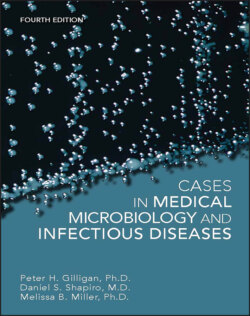Читать книгу Cases in Medical Microbiology and Infectious Diseases - Melissa B. Miller - Страница 68
CASE 10
ОглавлениеIn December 2009, a 45-year-old female presented to the emergency department (ED) 2 days following abrupt onset of sore throat, nonproductive cough, chills, and mild fever. A chest radiograph was performed, which was normal. She was diagnosed with bronchitis and asked to follow up with her primary care physician, who subsequently started her on levofloxacin and albuterol. Four days later she presented again to the ED with worsening cough, dyspnea, fever (38.3°C; 101°F), and generalized lethargy. Additionally, she reported new symptoms including a global headache, dizziness, myalgias, and arthralgias. She had no abdominal pain, but reported nausea and anorexia. Her chest radiograph showed diffuse reticulonodular opacities throughout the left lung, which were not present on her visit 4 days previously. The patient was admitted for further evaluation. Questioning revealed the following: she had a history of diabetes and hypertension, she smoked an average of a pack of cigarettes daily, and she had received the seasonal influenza vaccine. Her husband was recently ill with cough, but no other symptoms.
On day 2 of hospitalization the patient’s respiratory rate increased from 22 to 46 and her oxygen saturation dropped while on oxygen administered by nasal cannula. She was transferred to an intensive care unit, where her respiratory status quickly deteriorated, necessitating emergency intubation. A new chest radiograph showed bilateral involvement, and she was begun on vancomycin, aztreonam, and azithromycin. Blood cultures drawn on her admission were negative, and an expectorated sputum sample taken at the same time was not processed due to poor specimen quality. A PCR test performed on a nasopharyngeal swab was positive for a viral agent, revealing the etiology of her infection (Fig. 10.1).
1 1. What is the agent causing her infection? What are the key virulence factors of this agent?
2 2. How does this virus change over time? What made this virus unique in 2009?
3 3. Why was PCR used to diagnose this infection? What do the curves in Fig. 10.1 represent?
4 4. What is the usual outcome of this infection in this patient population? What groups of people are at greater risk of a poor outcome when they are infected with this virus? How did these groups differ in 2009?
5 5. What are the common complications associated with this infection that lead to increased morbidity and mortality? How are these complications diagnosed?
6 6. What antiviral drugs are available to treat this infection, and how do they work? Is there any concern for antiviral resistance?
7 7. Two types of licensed vaccines are available that can prevent this disease. Describe the nature of both of these vaccines and how they are used.
Figure 10.1 Amplification curves of a real-time PCR test.
